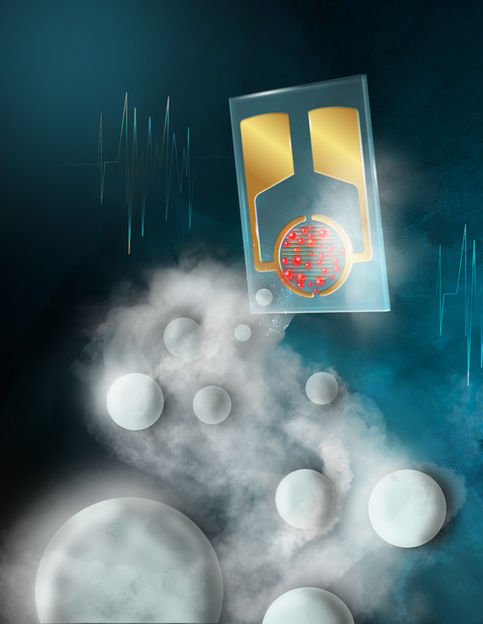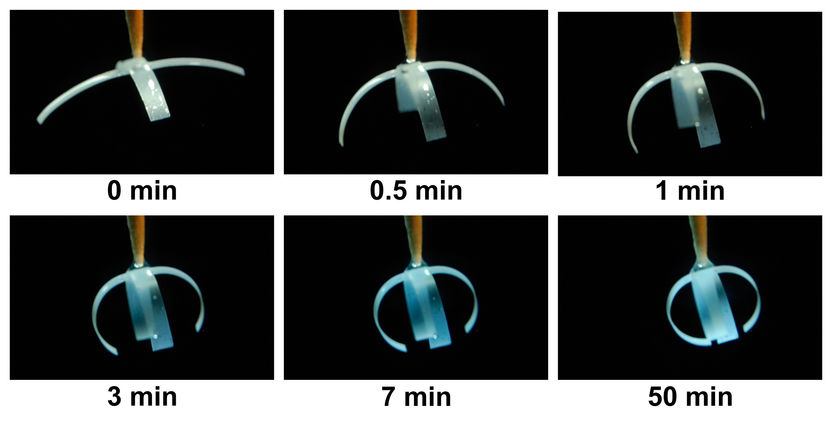Detecting nanoplastics in the air
“Nanoplastics are a major concern if they’re in the air that you breathe, getting into your lungs and potentially causing health problems”
Large pieces of plastic can break down into nanosized particles that often find their way into the soil and water. Perhaps less well known is that they can also float in the air. It’s unclear how nanoplastics impact human health, but animal studies suggest they’re potentially harmful. As a step toward better understanding the prevalence of airborne nanoplastics, researchers have developed a sensor that detects these particles and determines the types, amounts and sizes of the plastics using colorful carbon dot films.

In this illustration, a sensor containing red carbon dots detects nanoplastics in the air, which are represented by the floating spheres.
Nitzan Shauloff
This research was presented at the fall meeting of the American Chemical Society (ACS).
“Nanoplastics are a major concern if they’re in the air that you breathe, getting into your lungs and potentially causing health problems,” says Raz Jelinek, Ph.D., the project’s principal investigator. “A simple, inexpensive detector like ours could have huge implications, and someday alert people to the presence of nanoplastics in the air, allowing them to take action.”
Millions of tons of plastic are produced and thrown away each year. Some plastic materials slowly erode while they’re being used or after being disposed of, polluting the surrounding environment with micro- and nanosized particles. Nanoplastics are so small — generally less than 1-µm wide — and light that they can even float in the air, where people can then unknowingly breathe them in. Animal studies suggest that ingesting and inhaling these nanoparticles may have damaging effects. Therefore, it could be helpful to know the levels of airborne nanoplastic pollution in the environment.
Previously, Jelinek’s research team at Ben-Gurion University of the Negev developed an electronic nose or “e-nose” for monitoring the presence of bacteria by adsorbing and sensing the unique combination of gas vapor molecules that they release. The researchers wanted to see if this same carbon-dot-based technology could be adapted to create a sensitive nanoplastic sensor for continuous environmental monitoring.
Carbon dots are formed when a starting material that contains lots of carbon, such as sugar or other organic matter, is heated at a moderate temperature for several hours, says Jelinek. This process can even be done using a conventional microwave. During heating, the carbon-containing material develops into colorful, and often fluorescent, nanometer-size particles called “carbon dots.” And by changing the starting material, the carbon dots can have different surface properties that can attract various molecules.
To create the bacterial e-nose, the team spread thin layers of different carbon dots onto tiny electrodes, each the size of a fingernail. They used interdigitated electrodes, which have two sides with interspersed comb-like structures. Between the two sides, an electric field develops, and the stored charge is called capacitance. “When something happens to the carbon dots — either they adsorb gas molecules or nanoplastic pieces — then there is a change of capacitance, which we can easily measure,” says Jelinek.
Then the researchers tested a proof-of-concept sensor for nanoplastics in the air, choosing carbon dots that would adsorb common types of plastic — polystyrene, polypropylene and poly(methyl methacrylate). In experiments, nanoscale plastic particles were aerosolized, making them float in the air. And when electrodes coated with carbon-dot films were exposed to the airborne nanoplastics, the team observed signals that were different for each type of material, says Jelinek. Because the number of nanoplastics in the air affects the intensity of the signal generated, Jelinek adds that currently, the sensor can report the amount of particles from a certain plastic type either above or below a predetermined concentration threshold. Additionally, when polystyrene particles in three sizes — 100-nm wide, 200-nm wide and 300-nm wide — were aerosolized, the sensor’s signal intensity was directly related to the particles’ size.
The team’s next step is to see if their system can distinguish the types of plastic in mixtures of nanoparticles. Just as the combination of carbon dot films in the bacterial e-nose distinguished between gases with differing polarities, Jelinek says it’s likely that they could tweak the nanoplastic sensor to differentiate between additional types and sizes of nanoplastics. The capability to detect different plastics based on their surface properties would make nanoplastic sensors useful for tracking these particles in schools, office buildings, homes and outdoors, he says.
Most read news
Other news from the department science
These products might interest you

SprayMaster inspex by LaVision
Quality Control for Your Spraying Process Through Digital Spray and Particle Analysis
Reliable, Automated, Digital - The Geometry Measurement of Your Spraying Process in Real Time

FireSting-PRO by PyroScience
New fiber optic measuring device: Precise measurements even in the smallest volumes
Measure pH, oxygen and temperature even under sterile conditions

VEGAPULS | VEGABAR | VEGASWING by VEGA Grieshaber
Cyber-safe level measurement - here's how it works
Find out more about the unique sensor for liquid and solid media

Get the chemical industry in your inbox
By submitting this form you agree that LUMITOS AG will send you the newsletter(s) selected above by email. Your data will not be passed on to third parties. Your data will be stored and processed in accordance with our data protection regulations. LUMITOS may contact you by email for the purpose of advertising or market and opinion surveys. You can revoke your consent at any time without giving reasons to LUMITOS AG, Ernst-Augustin-Str. 2, 12489 Berlin, Germany or by e-mail at revoke@lumitos.com with effect for the future. In addition, each email contains a link to unsubscribe from the corresponding newsletter.
Most read news
More news from our other portals
See the theme worlds for related content
Topic World Particle Analysis
Particle analysis methods allow us to study tiny particles in various materials and reveal their properties. Whether in environmental monitoring, nanotechnology or the pharmaceutical industry, particle analysis gives us a glimpse into a hidden world where we can decipher the composition, size and shape of particles. Experience the fascinating world of particle analysis!

Topic World Particle Analysis
Particle analysis methods allow us to study tiny particles in various materials and reveal their properties. Whether in environmental monitoring, nanotechnology or the pharmaceutical industry, particle analysis gives us a glimpse into a hidden world where we can decipher the composition, size and shape of particles. Experience the fascinating world of particle analysis!
Topic world Sensor technology
Sensor technology has revolutionized the chemical industry by providing accurate, timely and reliable data across a wide range of processes. From monitoring critical parameters in production lines to early detection of potential malfunctions or hazards, sensors are the silent sentinels that ensure quality, efficiency and safety.

Topic world Sensor technology
Sensor technology has revolutionized the chemical industry by providing accurate, timely and reliable data across a wide range of processes. From monitoring critical parameters in production lines to early detection of potential malfunctions or hazards, sensors are the silent sentinels that ensure quality, efficiency and safety.



























































